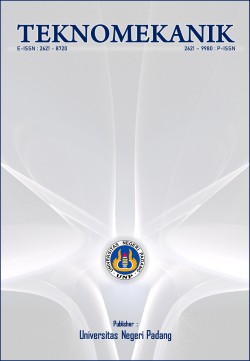Risk indentification on superheater pipeline boiler of 600 MW power plants using a risk based inspection (RBI) method
DOI:
https://doi.org/10.24036/jptk.v5i4.29523Keywords:
Risk Based Inspection, Steam Power Plant, Superheater Pipeline BoilerAbstract
Steam power plants are the most efficient type of power generation and can make a significant contribution to the demand for electricity resources. Steam power plants, in general, utilize energy derived from seawater to be process into steam in boilers so that often many pipe failures have occurred due to thinning due to corrosion caused by inappropriate water quality in small units and difficult to detect continuously. In general, inspection planning related to pipe thinning in steam power plants shows a minimal trend compared to inspections in the oil & gas industry. Moreover, it has no basic policy as to how inspection intervals and piping methods will be carry out. In this study, it carried out with the aim of conducting a risk assessment of boiler pipe failure so that it can provide a more optimal overview of the inspection plan. Analysis using Risk Based Inspection (RBI) will be used as a research reference to create the most effective and efficient inspection system as to minimize the impact and expenses cost in pipeline maintenance. After RBI assessment, the inspection plan for superheater pipeline on boiler line will be held every 2 years.
Downloads
References
Xin’an, Y., Wei, L., Guoming, C., Xiaokang, Y. & Jiuhao, G. (2017). Circumferential current field testing system with TMR sensor array for non-contact detection and estimation of cracks on power plant piping. Sensors and Actuators A: Physical,(2), 542 - 553.
Tong, L., Tao, J., Jiru, Z., Kaishu, G., Zihao, W., Farzin, A. (2022). Failure analysis of sulphidation-oxidation corrosion of Incoloy 800HT superheater tube. Engineering Failure Analysis, 142(3), 106795.
Perera, I. E., Sapko, M. J., Harris, M. L., Zlochower, I. A., & Weiss, E. S. (2016). Design and development of a dust dispersion chamber to quantify the dispersibility of rock dust. Journal of Loss Prevention in the Process Industries, 39, 7–16. https://doi.org/10.1016/j.jlp.2015.11.002
Noori, S. A., & Price, J. W. H. (2006). A risk approach to the management of boiler tube thinning. Nuclear Engineering and Design, 236(4), 405- 414 https://doi.org/10.1016/j.nucengdes.2005.09.019
American Petroleum Institutes (API). (2016). Risk-Based Inspection Methodology. American Petroleum Institute, 3rd Ed
Seo, J. K., Cui, Y., Mohd, M. H., Ha, Y. C., Kim, B. J., & Paik, J. K. (2015). A risk-based inspection planning method for corroded subsea pipelines. Ocean Engineering, 109,539–552. https://doi.org/10.1016/j.oceaneng.2015.07.066
Downloads
Published
Issue
Section
License
Copyright (c) 2022 okky helja octora syahida Rahman, fikri wahyu pratama, Eddy S Siradj

This work is licensed under a Creative Commons Attribution 4.0 International License.





